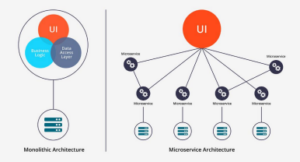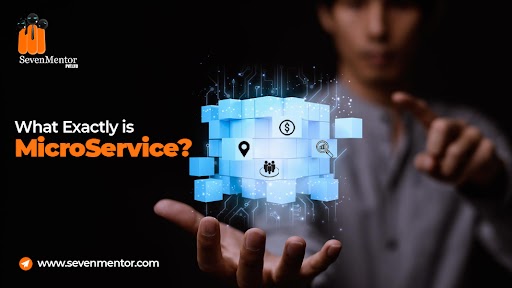What Exactly is MicroService?
Microservice is a hot buzzword today. Perhaps, it is one of the hottest topics in the IT industry. Many organizations have adopted built and deployed microservice in creating their applications. In this blog, we will discuss more about What Exactly is MicroService?
What Exactly is MicroService?
Here is the answer – Microservice application is a collection of small autonomous loosely coupled services each of which focuses on one thing exactly.
Microservices architecture is a technique of developing applications built as a suite of small services (microservice), where each of them answers to one function, like product search, payment or shipping.
For Free, Demo classes Call: 020-71173125
Registration Link: Click Here!
Microservices are an architectural model that better facilitates a desired operational model, For example, AccountService, CustomerService, OrderService, etc
You may have a question, why microservice is in great demand in IT World?
In order to thrive in today’s volatile, uncertain, complex, and ambiguous world, businesses must be nimble, agile, and innovate faster. Moreover, since modern businesses are powered by software. Software developers strive to craft effective and timely solutions to complex problems. most disciplined teams can struggle to sustain their early pace and agility in the face of a growing application. At worst, your once simple and stable product becomes both intractable and delicate. Instead of sustainably delivering more value to your customers, you’re fatigued from outages, anxious about releasing, and too slow to deliver new features or fixes. Neither your customers nor your developers are happy. Elevate your programming skills with comprehensive Java classes in Pune. Expert-led courses to master Java’s versatility and enhance your career prospects. Enroll now!
Monolithic Application:
If you go back into the history of application development and check, you will find most of the traditional applications are monolithic in nature. A monolithic application is a single large application divided among basic 3 layers:
Presentation or UI Layer
Business or Service Layer
Data Access Layer (DAO)
If you might have already created some such application you will find below the limitations or drawbacks associated with Monolithic Architecture.
- Single large Code Base: All the development teams involved in developing such applications need access to a single large code base. Making changes in such applications leads to re-compilation and re-packaging of the entire application which becomes inefficient to manage.
- Large team size: Due to the growing size of the application, team size grows so it becomes difficult to manage communication and coordination between different teams associated with the application.
- Overload IDE and Server: As the code grows, application size increases which can overload the development IDE and server while testing, building and executing the application. 4. Tightly Coupled: Though a monolithic application is logically divided among multiple layers, but modules associated with all these layers are compiled, built, and packaged together in a single application.
- Single Technology Stack: Once a particular technology stack is chosen for development, it’s impossible to select any other technology stack.
With above mentioned limitations or drawbacks you will find many other drawbacks associated with Monolithic Application
Microservice Application:
The microservice application solves these problems associated with Monolithic Applications. Microservices mean no more monoliths. Monoliths are often big, clunky, slow, and inefficient. Benefits of Microservice Application
- Small, manageable code base: Each microservice is a small (micro) application that runs in its own process. So ultimately codebase is different for each microservice
- Independent Small Team Size: Each microservice can be developed by the small, two-pizza team which can work independently of any other team developing another microservice
3. No overload on IDE and Server: Due to the small code base, IDE and server are not overloaded
4. Loosely Coupled: Each microservice is a separate application that can run on it’s own server. Making changes in one microservice does not affect another microservice. - Different Technology Stack: Each microservice has it’s own technology stack and programming languages along with Database and data management model.
For Free, Demo classes Call: 020-71173125
Registration Link: Click Here!
There are many more benefits of Microservice Architecture

In a nutshell, instead of a single complex system, you build and manage a suite of relatively simple services that might interact in complex ways. These services collaborate with each other through technology-agnostic messaging protocols, either point-to-point or asynchronously.
Characteristics of Microservice
- Microservice follows SRP (Single Responsibility Principle): Each microservice focuses on only one thing whether by business task, functionality or technical capability, etc
- Highly Cohesive in nature: As microservice focuses on only a single task, it becomes highly cohesive
- Separate Data Store: Each microservice owns its own Data Store which in turn reduces coupling
- Loose coupling: Each microservice itself is a separate application running in its own process. Hence they are loosely coupled.
- Independently deployable: Having its own technology stack, data store, and running in a separate process, Microservice can be deployed independently.
- Replaceable: Having a single capability places natural bounds on size; likewise, it makes the individual responsibility, or role, of a service easy to comprehend
- Scalable: It allows scaling an application by increasing or decreasing the number of microservice applications
Microservices communicate with each other over a combination of REST APIs, event streaming, and message brokers.
A lot of people think SOA and microservices are the same thing.
SOA stands for Service Oriented Architecture.
For Free, Demo classes Call: 020-71173125
Registration Link: Click Here!
By definition, they both look the same, but SOA is usually used for communicating different systems over an ESB (Enterprise Service Bus), where the ESB takes a lot of responsibility to manage data, categorization, etc. SOA is an enterprise-wide effort to standardize the way all web services in an organization talk to and integrate with each other, whereas microservices architecture is application-specific.
Do watch out the latest video on Java: Click Here
Microservices are optimized for DevOps and CI/CD (Continuous Integration/Continuous Delivery)
Many organizations in the world have adopted Microservice Architecture in developing their application. These big companies, as well as startups, build their systems using monolithic architecture. They start out this way as in the initial phase of projects it is much faster to set up a monolith and get the business moving. After some time, problems arise due to maturing projects or fat growth. With the system’s growth, the code gets more complicated, the architecture more complex and we need more developers to maintain it. At the same time, we lose speed, flexibility, and agility which makes it harder to react to the market’s needs. Learn fundamentals to advanced concepts, unlock your coding potential, and build robust applications with SevenMentor’s Best Java Course in Pune
Not surprised but below are the top organizations currently using Microservice such as Netflix, Amazon, eBay, Spotify, Git.com, Uber
Author:-
Dharamraj Pawale
Call the Trainer and Book your free demo Class For Java Call now!!!
| SevenMentor Pvt Ltd.
© Copyright 2021 | SevenMentor Pvt Ltd.

